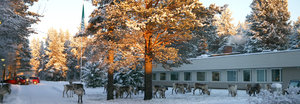Kolari Research Unit

Station Features
Opening year: 1964 Status: OpenFacilities
Station name and owner
The Kolari Research Unit belongs to the Natural Resources Institute Finland.
Location
The Kolari Reseach Unit is located in northwest Finland at 67° N, close to the Swedish border. The surrounding area consists of northern boreal taiga forests and swamps, as well as mountains up to 700 m a.s.l. Kolari village is approximately 4 km, and the Muonio River is approximately 300 meters away from the station. The Pallas-Ylläs National Park is located 30 km from station. With almost half a million annual visitors, it is Finland’s best known national park.
Climate data
Grey colours are WMO Climate Normals including maximum and minimum values. Blue colours are individual years.
Climate data for the stations where extracted via Copernicus Climate Data Store, from the global gridded reanalysis product: ERA5 monthly averaged data on single levels from 1940 to present. Description and source code: Roemer J.K. 2023. https://doi.org/10.5281/zenodo.10214922 Data Source: Hersbach et al. 2023. Copernicus Climate Change Service (C3S) Climate Data Store (CDS), https://doi.org/10.24381/cds.f17050d7
Biodiversity and natural environment
Geographically, the Kolari area is located between Northern Finland, Forest Lapland and Fell Lapland, making it a very varied and interesting habitat. Kolari is situated at the western limit of the Russian taiga. The area is characterised as a mixture zone of eastern and western species of flora and fauna and includes old pine forest, wetlands, lakes, and rivers. Bears, moose, and reindeer are found in the area, the latter both as wild game and domesticated. Snow covers the landscape from November to May.
History and facilities
The Kolari Research Unit was established in 1964 for the study of peat lands. Today we focus on sustainable use of northern timberline forests and integration of different nature-based livelihoods also with respect to rapidly growing mining activities in this area. The station has 15 offices, high speed internet, and guestrooms for visitors. Kolari village offers various services, and a broad range of outdoor activities is possible in the nearby Ylläs National Park.
General research and databases
The research at Kolari focuses on the integration of different nature-based livelihoods at the timberline (tourism, reindeer herding, and forestry), ecologically sustainable forestry, nature protection, and plant ecology. The main objectives of the ecological projects are to study the dynamics of natural forests and disturbance dynamics of forest fires. Existing databases include a bibliography of publications arising from research at the station, as well as long term ecological data concerning timberline regeneration, rodents, seed yield, and phenology.
Station Monitoring
Human dimension
The nearest community is Kolari village (five km away) with approximately 1500 inhabitants. A bit larger is the Swedish Pajala (c. 6200 inhabitants) which is located 30 km from the Kolari Research Unit. Most of the local people are of Finnish origin with long and strong ties to the area and also to the Sami people. The border to the Finnish Sami region is 100 km to the north but it is only two km away from the Swedish Sami region. Tourism and public services are nowadays the main economic factors, but reindeer herding still plays an important role in the area as well as other land uses like forestry and agriculture. Fishing, hunting, and recreational use of the nature are all essential parts of the local culture and provide great opportunities for various outdoor activities.
Access
You can reach Kolari Research Unit easily by car, train or airplane. We are located along Highway 21 from Tornio to Kilpisjärvi. The railway station is less than one km away. Nearest airport is Kittilä Airport 75 km from the station.

